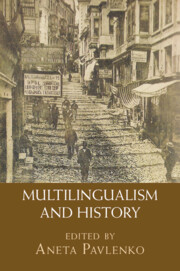Book contents
- Multilingualism and History
- Multilingualism and History
- Copyright page
- Contents
- Figures
- Contributors
- Acknowledgments
- 1 Multilingualism and Historical Amnesia: An Introduction
- 2 Greek Meets Egyptian at the Temple Gate: Bilingual Papyri from Hellenistic and Roman Egypt (Third Century BCE–Fourth Century CE)
- 3 Language Shift, Attitudes and Management in the Roman West
- 4 Languages at War: Military Interpreters in Antiquity and the Modern World
- 5 How Multilingualism Came to Be Ignored in the History of Standard English
- 6 Multilingualism and the Attitude toward French in the Latin Kingdom of Jerusalem
- 7 Why Colonial Dutch Failed to Become a Global Lingua Franca
- 8 How Unique Was Russia’s Multilingual Elite?
- 9 Language Ideology and Observation: Nineteenth-Century Scholars in Northwestern Siberia
- 10 Studying Historical Multilingualism in Everyday Life: The Case of the Habsburg Monarchy in the Nineteenth Century
- 11 Multilingualism and the End of the Ottoman Empire: Language, Script, and the Quest for the ‘Modern’
- 12 “Multilingualism Is Now a Must”: Discourses on Languages and International Cooperation at the Council of Europe
- 13 The Role of the Past in Language Revitalization
- 14 Historic Reenactments in Contemporary Spain: Fiestas de moros y cristianos
- 15 Multilingual Ghost Signs: Dissonant Languages in the Landscape of Memory
- Index
- References
14 - Historic Reenactments in Contemporary Spain: Fiestas de moros y cristianos
Published online by Cambridge University Press: 20 April 2023
- Multilingualism and History
- Multilingualism and History
- Copyright page
- Contents
- Figures
- Contributors
- Acknowledgments
- 1 Multilingualism and Historical Amnesia: An Introduction
- 2 Greek Meets Egyptian at the Temple Gate: Bilingual Papyri from Hellenistic and Roman Egypt (Third Century BCE–Fourth Century CE)
- 3 Language Shift, Attitudes and Management in the Roman West
- 4 Languages at War: Military Interpreters in Antiquity and the Modern World
- 5 How Multilingualism Came to Be Ignored in the History of Standard English
- 6 Multilingualism and the Attitude toward French in the Latin Kingdom of Jerusalem
- 7 Why Colonial Dutch Failed to Become a Global Lingua Franca
- 8 How Unique Was Russia’s Multilingual Elite?
- 9 Language Ideology and Observation: Nineteenth-Century Scholars in Northwestern Siberia
- 10 Studying Historical Multilingualism in Everyday Life: The Case of the Habsburg Monarchy in the Nineteenth Century
- 11 Multilingualism and the End of the Ottoman Empire: Language, Script, and the Quest for the ‘Modern’
- 12 “Multilingualism Is Now a Must”: Discourses on Languages and International Cooperation at the Council of Europe
- 13 The Role of the Past in Language Revitalization
- 14 Historic Reenactments in Contemporary Spain: Fiestas de moros y cristianos
- 15 Multilingual Ghost Signs: Dissonant Languages in the Landscape of Memory
- Index
- References
Summary
Spain is known for having multiple languages that coexist in different geographical regions with varying degrees of political and social recognition. At the same time, Spanish historiography, argues historian García Sanjuán (2012), has been dominated by the nationalist discourse that systematically distorts the past to construct a “Spanish” and an “Andalusian” identity predicated on the exclusion of anything associated with the Arabic language and Islam, all the while the tourism sector commodifies the “exotic” Arabic past. One of the key settings that distorts and reinvents the past are the festivals of moros y cristianos, Moors and Christians. Claiming to be true and faithful retellings of history, these festivals invoke a popular memory of the imagined past, while interlacing and mixing events from multiple time periods, from the Muslim conquest of the Iberian Peninsula in 711 to the so-called Christian reconquest, presented as an essential battle between Christianity and the Muslim invaders. In this article, I analyze one of the more popular and historically significant of these festivals, celebrated in the outpost village of Carboneras. I show that the festivals of moros y cristianos help engrain the legitimacy of nationalist ideas that seek to generate a specific hegemonic identity grounded in an affirmation of the Roman-Latin-Christian vision of the past. The language utilized in the festivals is purposefully selected to elevate and justify the actions and attitudes of the Christians and to amalgamate the identity of Moriscos, whose families had lived in these lands for centuries with that of moros from across the Mediterranean. The reenactments that skillfully play with, confuse, and obscure several periods in Spain’s history are a theatrical mirror of a real process of linguistic and social exclusion that reaches from the past to the present day.
Keywords
- Type
- Chapter
- Information
- Multilingualism and History , pp. 255 - 269Publisher: Cambridge University PressPrint publication year: 2023

